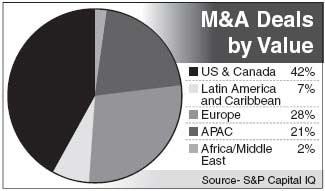Identifying opportunities to move up value chain
Updated: 2012-10-30 13:13
By Paul B Mccuinness (China Daily)
|
||||||||
The current financial crisis has led to a new wave of consolidations, with dramatic effects on the Merger & Acquisition (M&A) activities of Chinese companies. Several key drivers are behind the recent surge in outbound M&A deals done by Chinese companies, but these companies face real challenges in the near future.

The M&A future looks bright for Chinese companies. With lower valuations and unbalanced wealth there is even greater scope for cash-rich companies to strike deals with least resistance. Data from S&P Capital IQ reveals that, after a slowdown in 2009, global M&A activity has been on the rise, and the Asia-Pacific (APAC) region has become the focal point of M&A activities, accounting for 21 percent of global deals. Within Asia Pacific, Greater China was the major contributor, accounting for 37 percent of total transaction value.
Chinese University of Hong Kong researchers' analysis of S&P Capital IQ, shows that given the economic environment and especially the rising demand of domestic consumers, Chinese companies are likely to continue to pursue overseas acquisitions.
Chinese government support for state-owned and private enterprise investment in offshore assets is very apparent. This is evident from its 12th Five-Year Plan and the fact that the Chinese authority is seeking ways to streamline approval processes for M&A deals. Recent government policy and moves to stimulate domestic consumption also point to increased M&A activity in the future. Policies and demographic trends also hint at an increased focus on acquisitions specifically in the Healthcare and IT sectors.
Our analysis also reveals that China's outbound M&A activities are growing at a much faster rate than inbound activities due to the growing power of Chinese companies, which have amassed wealth in recent years due to their net exporters' role. Now the same companies are looking at moving up the value chain to meet ever-increasing domestic demand. Outbound M&A has been growing at a 21 percent rate and has already registered an 11 percent increase in deals this year from the same time last year (as of June 2012).
Historically, Chinese companies would look at American companies as targets. However, the trend is fast changing with more and more European companies being approached by Chinese companies looking for established brand and quality products. With average valuation measures drastically decreasing, Chinese companies have a great opportunity to secure targets at better valuations while avoiding high leverage.
Another important reason for M&A activity is the strong IPO funding base available to Chinese companies. Ability to raise cash plays an important role in M&A decisions. S&P Capital IQ data shows that 87 percent of Chinese companies involved in outbound M&A were listed firms.
While M&A deals may give quick access to existing brands and technology, challenges remain for Chinese companies seeking overseas acquisitions. Integration difficulties may delay or ultimately thwart the exploitation of synergies. Proper due diligence on the operational and management set up helps companies to identify targets which are best fits.
It is clear that Chinese companies must move up the value chain and leverage on the resources they have amassed in recent years to continue growth. Meanwhile, as domestic demand increases, more and more foreign companies will likely enter the Chinese marketplace. For Chinese firms to compete against their global competitors, they need a faster and more robust way to protect and build market share.
China is likely to be at the forefront of global M&A for the foreseeable future, but success will ultimately depend on companies' ability to integrate foreign operations and realize synergies.
The author is a professor in the Department of Finance at the Chinese University of Hong Kong Business School. His analysis was co-written by Business School students Nitin Damondaran, Rahul Oberai, Suppe Tang and Ben Zhao.

 Relief reaches isolated village
Relief reaches isolated village
 Rainfall poses new threats to quake-hit region
Rainfall poses new threats to quake-hit region
 Funerals begin for Boston bombing victims
Funerals begin for Boston bombing victims
 Quake takeaway from China's Air Force
Quake takeaway from China's Air Force
 Obama celebrates young inventors at science fair
Obama celebrates young inventors at science fair
 Earth Day marked around the world
Earth Day marked around the world
 Volunteer team helping students find sense of normalcy
Volunteer team helping students find sense of normalcy
 Ethnic groups quick to join rescue efforts
Ethnic groups quick to join rescue efforts
Most Viewed
Editor's Picks

|

|

|

|

|

|
Today's Top News
Health new priority for quake zone
Xi meets US top military officer
Japan's boats driven out of Diaoyu
China mulls online shopping legislation
Bird flu death toll rises to 22
Putin appoints new ambassador to China
Japanese ships blocked from Diaoyu Islands
Inspired by Guan, more Chinese pick up golf
US Weekly

|

|






